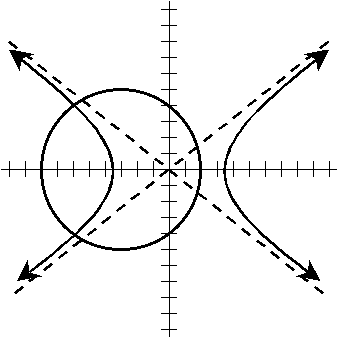1.(a)
B2 4AC = 22 4(0)(0) = 4 > 0 Þ hyperbola
(b)
B2 4AC = 02 4(177)(3497) < 0 Þ ellipse
[Clearly, the answer is negative. As long as you show work in this manner, there is no need to compute the actual numeric value of the discriminant.]
(c)
B2 4AC = 02 4(34)(34) > 0 Þ hyperbola
(d)
B2 4AC = 02 4(34)(34) < 0 Þ ellipse
[Actually, a better answer would be circle since the coefficients on the x2 and y2 terms are equal.]
(e)
Since A and B are both 0, B2 4AC = 0 Þ parabola.
(f)
Same as part (e): parabola again.
(g)
This time B and C are both 0. Thus B2 4AC = 0 Þ parabola.
(h)
Rewrite as 3x2 + 2y2 = 0 to see that A = 3, B = 0, C = 2. Therefore, B2 4AC = 02 4(3)(2) = 24 > 0 Þ hyperbola.
[Another approach is to solve the original equation for y. Taking square roots of both sides gives ![]() , which is a pair of lines passing through the origin with slopes
, which is a pair of lines passing through the origin with slopes ![]() . This pair of lines is what we would more properly call a degenerate hyperbola. The hyperbola has fused into its asymptotes and has simply become a graph in the shape of an "X."]
. This pair of lines is what we would more properly call a degenerate hyperbola. The hyperbola has fused into its asymptotes and has simply become a graph in the shape of an "X."]
- 2.(c)
34x2 34y2 = 915
34x2/915 34y2/915 = 1
x2/(915/34) y2/(915/34) = 1
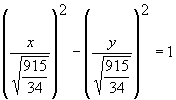
a = rx = ![]()
b = ry = ![]()
c2 = a2 + b2 = 915/34 + 915/34 = 915/17
c = ![]()
Since b/a = 1, asymptotes have slope ± 1.
Center is at (0, 0).
Foci are at (7.336, 0) and (7.336, 0).
For y-intercepts, set x = 0 in big equation above to get 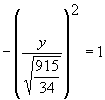 . Since this is impossible [the negative of a squared expression cannot equal 1], there are no y-intercepts.
. Since this is impossible [the negative of a squared expression cannot equal 1], there are no y-intercepts.
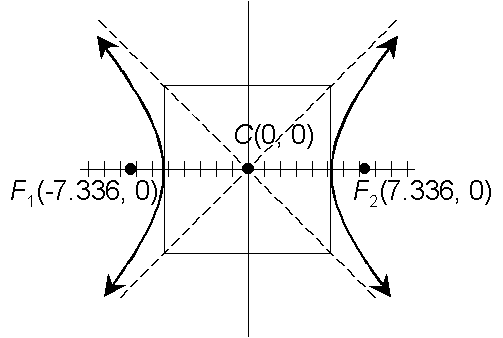
(d)
34x2 + 34y2 = 915
x2/34 y2/34 = 915/34
Circle with center (0, 0) and radius ![]()
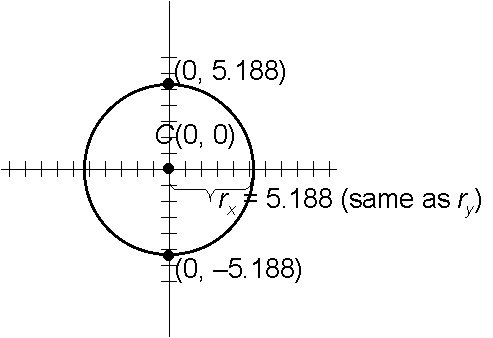
(f)
2x = 3y2 6y + 7
2x 7 = 3y2 6y
2x 7 = 3(y2 2y)
2x 7 + 3 = 3(y2 2y + 1)
2x 4 = 3(y 1)2
x 2 = 3/2 (y 1)2
Vertex is at (2, 1).
To find x-intercept, set y = 0 to get x 2 = 3/2 (0 1)2 Þ x 2 = 3/2 Þ x = 7/2.
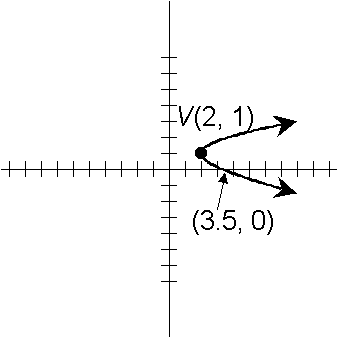
- 3.(a)
- parabola
[It is true that we did not discuss this. However, you should be able to get this by process of elimination, since all the other conic sections are described elsewhere.]
(b)
- circle
(c)
- ellipse
(d)
- hyperbola
- 4.(a)
- Major axis: 2a = 7 (3) = 10 Þ a = 5
c = 4.25 (given)
c2 = a2 b2
4.252 = 52 b2
b2 = 52 4.252 = 6.9375 = 111/16

Center is halfway between the 2 given pts., namely at (2, 2).
Equation:
However, this problem required Ax2 + Bxy + Cy2 + Dx + Ey + F = 0 form. Multiplying out gives
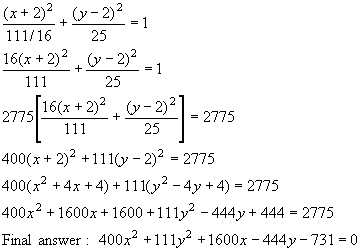
(b)
- Center is where asymptotes cross, i.e., (8, 0).
Since center is on x-axis, the vertices are, too.
Vertices are 2.5 units to left and right of center.
\ rx = a = 2.5
Since asymptote slopes are ± 3, we know ± 3 = ± b/a.
3 = b/a Þ 3 = b/2.5 Þ b = 7.5
Equation:
(c)
- x
By symmetry, y-coordinate of vertex is halfway between 4 and 8, so k = 2.
Our equation is thus x h = a(y 2)2
We know 3 points: (5, 0), (0, 4), and (0, 8).
Plug (5, 0) into our equation from above:
x h = a(y 2)2
5 h = a(0 2)2
5 h = 4a
h = 4a 5
Now, plug either of the other 2 points [i.e., (0, 4) or (0,8)] into our equation from above:
x h = a(y 2)2
0 h = a(36)
h = 36a
Compare the 2 underlined results. Since h = 4a 5 and h = 36a, we must have 4a 5 = 36a Þ 32a = 5 Þ a = 5/32. [This value for a makes sense, because the parabola is fairly fat and opens leftward. The only remaining unknown is h.]
From above, h = 36a Þ h = 36a Þ h = 36(5/32) = 45/8.
Final answer: x 45/8 = 5/32 (y 2)2
[This equation makes sense, since it defines a leftward-opening parabola with vertex at (45/8, 2).]
(d)
- r
r2 = 64/9
Equation: (x 2/3)2 + (y + 1)2 = 64/9
- 5.
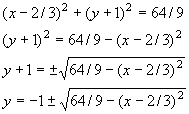
Calculator: Y1=1+Ö (64/9(X2/3)2)
[Note: Remember to use the negation sign, marked () on your calculator, in front of the 1. If you use the subtraction sign there, the function will not work.]
Y2=2nd RCL VARS Y-VARS Function 1 ENTER
[For Y2, change the + sign just before the radical to a subtraction sign.]
Display graph with ZOOM 6.
[Optional: Follow with ZOOM 5 to show circle in proper proportions.]
- 6.
- 16x2 + 9y2 128x + 18y < 311
16(x2 8x) + 9(y2 + 2y) < 311
16(x2 8x + 16) + 9(y2 + 2y + 1) < 311 + 16(16) + 9(1)
16(x 4)2 + 9(y + 1)2 < 576
16(x 4)2/576 + 9(y + 1)2/576 < 1
(x 4)2/36 + (y + 1)2/64 < 1
This is the interior of an ellipse with center (4, 1), x-radius 6, and y-radius 8.
The second inequality becomes y ³ 2x + 18, i.e., the region at and above the line with slope 2 and y-intercept 18. Clearly, the regions do not overlap. Solution set: Æ .
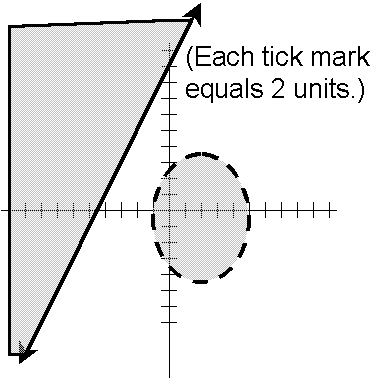
- 7.
- x
2x2 3y2 = 24
__________________
[Various methods are possible. One is to multiply first eqn. by 3, then add.]
3x2 + 3y2 + 18x = 48
2x2 3y2 = 24
__________________
5x2 + 18x = 72
5x2 + 18x 72 = 0

x = 2.4 or x = 6
Consider both of these cases:
First, if x = 2.4, plug into either original eqn. [second one is easier] to get
2(2.4)2 3y2 = 24
3y2 = 24 2(2.4)2
3y2 = 12.48
y2 = 4.16
This is impossible in Â. [That is, x = 2.4 is a dead end.]
Second case: plug x = 6 into either original eqn. [second one is easier] to get
2(6)2 3y2 = 24
3y2 = 24 2(36)
3y2 = 48
y2 = 16
y = ± 4
Solution set: {(6, 4), (6, 4)}
[This makes sense if you graph the circle and hyperbola represented by the original system of equations. See optional graph below.]
